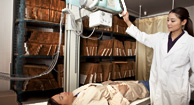Kegel Exercises for Your Pelvic Muscles
How do pelvic muscles get weak?
Pelvic muscles help stop the flow of urine. For women, pregnancy, childbirth and being overweight can weaken the pelvic muscles. For men, prostate surgery can weaken pelvic muscles. Weak pelvic muscles can cause you to leak urine. Fortunately, pelvic muscles are just like other muscles--exercises can make them stronger. People who leak urine may have better control of these muscles by doing pelvic muscle exercises called Kegel exercises.
This handout focuses on Kegel exercises for women because it is much more common for women to leak urine than for men. If you are a man who leaks urine, talk to your doctor about whether Kegel exercises can help you.
Which muscles control my bladder?
At the bottom of the pelvis, several layers of muscle stretch between your legs. The muscles attach to the front, back and sides of the pelvic bones. Two pelvic muscles do most of the work. The biggest one stretches like a hammock. The other is shaped like a triangle (see picture below).
How do I exercise my pelvic muscles?
You can exercise almost anywhere and any time--while driving in a car, at your desk or watching TV. To exercise these muscles, just pull in or "squeeze" your pelvic muscles (as if you are trying to stop urine flow). Hold this squeeze for about 10 seconds, then rest for 10 seconds. Do sets of 10 to 20 contractions per day.
Be patient and continue to exercise. It takes time to strengthen the pelvic muscles, just like it takes time to improve the muscles in your arms, legs or abdomen. You may not notice any change in bladder control until after 6 to 12 weeks of daily exercises. Still, most women notice an improvement after just a few weeks.
These are the same muscles that you would use to try to stop the flow of urine. They are the muscles you will exercise and strengthen.
A few points to remember
- Weak pelvic muscles often lead to urine leakage.
- Daily exercises can strengthen pelvic muscles.
- These exercises often improve bladder control.
- Ask your doctor or nurse if you are squeezing the right muscles.
- Tighten your pelvic muscle before sneezing, lifting a heavy object or jumping. This can prevent pelvic muscle damage and urine leakage.
Daily pelvic muscle exercise log
I exercised my pelvic muscles ______ times daily.
I spent _____ minutes exercising.
At each exercise session, I contracted my pelvic muscles _____ times.
















